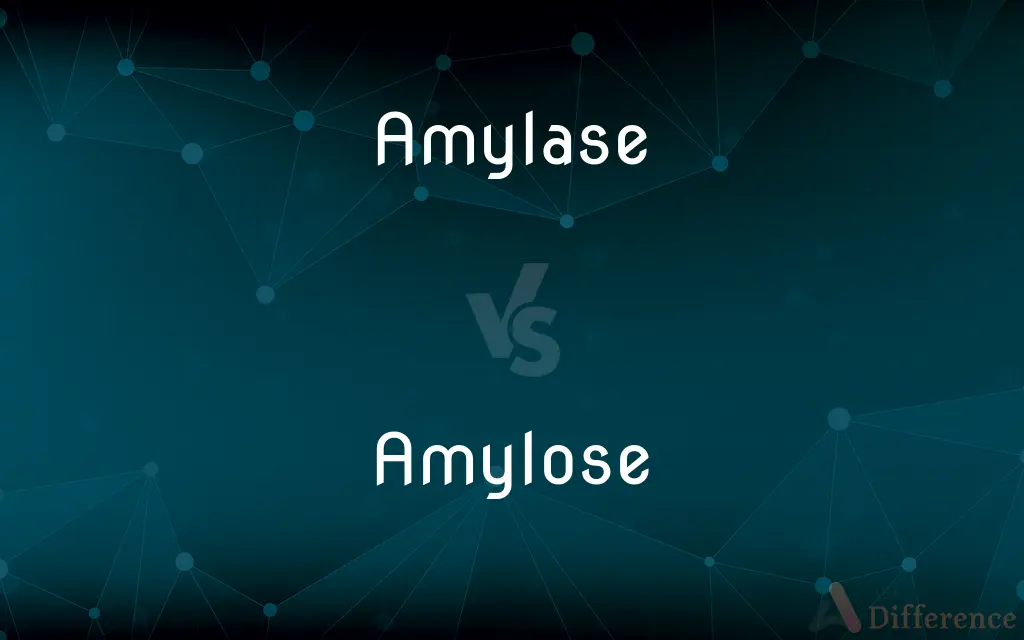Amylase vs. Amylose — What's the Difference?
Edited by Tayyaba Rehman — By Fiza Rafique — Updated on September 27, 2023
Amylase is an enzyme that breaks down starch, while amylose is a polysaccharide that constitutes a component of starch.

Difference Between Amylase and Amylose
Table of Contents
ADVERTISEMENT
Key Differences
Amylase is an enzyme found primarily in saliva and pancreatic juice, playing a crucial role in digesting dietary carbohydrates. On the other hand, amylose is one of the two main components of starch, with the other being amylopectin.
While amylase functions to catalyze the hydrolysis of starch into simpler sugars, aiding in digestion, amylose serves as a storage form of energy in plants, consisting of long, unbranched chains of glucose molecules.
Amylase can be categorized into two main types: salivary amylase and pancreatic amylase. These enzymes have specific roles in different parts of the digestive system. In contrast, amylose exhibits a helical structure, allowing it to form complexes with iodine, resulting in a characteristic blue color.
Enzymatic activity of amylase can be measured in medical diagnostics to detect pancreatic disorders. In the realm of food and plants, amylose content determines certain properties of starch, such as gelatinization temperature and texture.
In summary, while amylase is a biocatalyst crucial for the digestive process, amylose is a structural component of starch, vital for energy storage in plants.
ADVERTISEMENT
Comparison Chart
Type
Enzyme
Polysaccharide
Function
Breaks down starch
Storage form of energy in plants
Presence
Saliva and pancreatic juice
Component of starch
Structure
Protein
Long, unbranched chains of glucose molecules
Interaction
Acts on starch molecules
Interacts with iodine to give blue color
Compare with Definitions
Amylase
An enzyme involved in carbohydrate digestion.
Salivary amylase begins the breakdown of starch in the mouth.
Amylose
A linear polysaccharide present in starch.
The ratio of amylose to amylopectin affects the texture of cooked rice.
Amylase
A catalyst for hydrolyzing starch into simpler sugars.
Amylase is essential for converting dietary starch into usable energy.
Amylose
Associated with certain textural properties in food.
Foods with more amylose often have a firmer texture upon cooking.
Amylase
Found in saliva and pancreatic juice.
The presence of amylase in saliva helps initiate the digestion of bread.
Amylose
Represents one of the two primary components of starch.
Plants store energy as starch, which has both amylose and amylopectin components.
Amylase
Used in medical diagnostics to assess pancreatic health.
Elevated amylase levels can indicate pancreatic inflammation.
Amylose
Composed of unbranched chains of glucose units.
High amylose content can make foods less sticky after cooking.
Amylase
Enzyme with specificity for starch molecules.
Without amylase, the digestion of starchy foods would be challenging
Amylose
Forms a helical structure capable of trapping iodine.
The blue coloration in the iodine test for starch is due to amylose.
Amylase
An amylase () is an enzyme that catalyses the hydrolysis of starch (Latin amylum) into sugars. Amylase is present in the saliva of humans and some other mammals, where it begins the chemical process of digestion.
Amylose
Amylose is a polysaccharide made of α-D-glucose units, bonded to each other through α(1→4) glycosidic bonds. It is one of the two components of starch, making up approximately 20-30%.
Amylase
Any of a group of enzymes that catalyze the hydrolysis of starch to sugars. In humans, amylases are produced in the salivary glands and the pancreas.
Amylose
A linear, unbranched polysaccharide that is one of the two main components, along with amylopectin, of starches.
Amylase
(enzyme) Any of a class of digestive enzymes, present in saliva and also contributed to the gut by the exocrine pancreas, that break down complex carbohydrates such as starch into simpler sugars such as glucose.
Egg yolk amylase
Amylose
(carbohydrate) The soluble form of starch (the insoluble form being amylopectin) that is a linear polymer of glucose.
Amylase
Any of a group of proteins found in saliva and pancreatic juice and parts of plants; help convert starch to sugar
Amylose
One of the starch group (C6H10O5)n of the carbohydrates; as, starch, arabin, dextrin, cellulose, etc.
Common Curiosities
What is amylase?
Amylase is an enzyme that breaks down starch into simpler sugars.
How is amylase related to digestion?
Amylase catalyzes the hydrolysis of starch, aiding in carbohydrate digestion.
What is amylose?
Amylose is a linear polysaccharide that constitutes a component of starch.
Why does amylose form a blue complex with iodine?
Amylose exhibits a helical structure that can trap iodine, resulting in a blue color.
Where is amylase primarily found?
Amylase is primarily found in saliva and pancreatic juice.
What happens if there's a deficiency of amylase in the body?
A deficiency of amylase can lead to difficulties in digesting starchy foods.
How does the content of amylose affect food properties?
Amylose content can influence the gelatinization temperature, texture, and other properties of starchy foods.
Are amylase supplements available?
Yes, amylase supplements are available to aid in the digestion of starchy foods.
What role does amylose play in plants?
Amylose serves as a storage form of energy in plants.
Can amylase levels be used in medical diagnosis?
Yes, amylase levels can be measured to detect pancreatic disorders.
What is the other main component of starch besides amylose?
The other main component of starch is amylopectin.
Why is amylose important in the food industry?
Amylose content influences various properties of food, such as texture, shelf-life, and mouthfeel.
How is amylose different from amylopectin?
Amylose is a linear, unbranched polysaccharide, while amylopectin has a branched structure.
In which foods might you find high amylose content?
Foods like certain varieties of rice and corn might have a high amylose content.
What are the main types of amylase?
The main types of amylase are salivary amylase and pancreatic amylase.
Share Your Discovery

Previous Comparison
Eaten vs. Ate
Next Comparison
Coercion vs. PersuasionAuthor Spotlight
Written by
Fiza RafiqueFiza Rafique is a skilled content writer at AskDifference.com, where she meticulously refines and enhances written pieces. Drawing from her vast editorial expertise, Fiza ensures clarity, accuracy, and precision in every article. Passionate about language, she continually seeks to elevate the quality of content for readers worldwide.
Edited by
Tayyaba RehmanTayyaba Rehman is a distinguished writer, currently serving as a primary contributor to askdifference.com. As a researcher in semantics and etymology, Tayyaba's passion for the complexity of languages and their distinctions has found a perfect home on the platform. Tayyaba delves into the intricacies of language, distinguishing between commonly confused words and phrases, thereby providing clarity for readers worldwide.















































